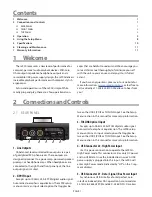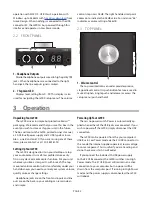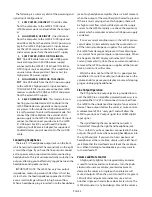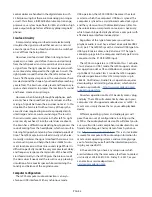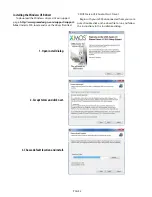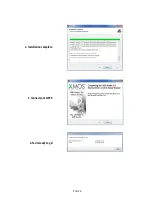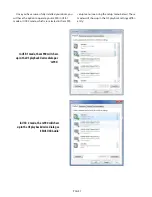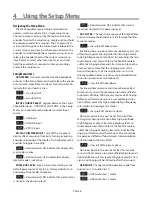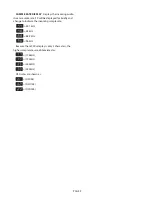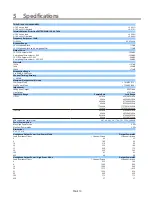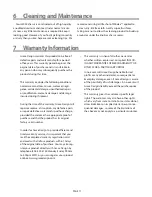
PAGE 4
control duties are handled in the digital domain with
32 bit processing but there are two analog gain ranges
as well. This allows a full 99dB of volume control range,
preserves a very low noise floor for IEMs, and allows high
peak output voltage for low efficiency planar magnetic
phones.
Crossfeed Circuitry
A completely analog crossfeed circuit electronically
simulates the signal crossfeed that occurs in a natural
acoustic space. The crossfeed function can be switched
on or off from the Setup Menu.
How does crossfeed work? When listening to loud-
speakers in a room, your left ear hears sound primarily
from the left speaker (and vice versa) but also receives
a signal from the right speaker at a lower level and with
some time delay compared to the right ear. As well, the
right speaker sound that reaches the left ear does not
have a flat frequency response as the sound waves have
traveled around the shape of your head before reaching
your left ear. The brain uses delay, level and frequency re-
sponse characteristics to process the location of a sound
and hence, create an aural image.
However, when listening through headphones, each
ear only hears the sound from one transducer and the
mixing of signals between the ears does not exist. In this
situation the brain is left without many of the psycho
acoustic clues required to generate a properly distrib-
uted image and an accurate sound stage. The result is
that instruments seem to cluster in the far left, far right
or center of your head. Since the vital clues are absent,
the brain has a difficult time deciding how to process the
sounds coming from the headphone, which can result in
listening fatigue when listening for extended periods of
time. The m900 contains crossfeed circuitry which elec-
tronically simulates the signal crossfeed that occurs in a
real acoustic space and helps the brain establish instru-
ment locations across the entire sound stage. While it is
difficult to perfectly model the very complex level, delay
and frequency response characteristics of the head, the
crossfeed circuitry in the m900 gives the brain some of
the basic clues it needs and the result is a very pleasing
simulation of an acoustic space while maintaining the
tonality and balance of the original source.
Computer Configuration
The m900 computer audio connection is an asyn-
chronous USB interface. With asynchronous mode
USB operation, the m900 USB DAC becomes the clock
master to which the computer’s USB bus is synced. The
computer is synced to a crystal-based audio clock signal
and the system works with dramatically lower jitter. No
phase-lock loop or sample rate conversion is necessary,
which means bit-perfect playback from a computer with
effectively zero interface induced jitter.
Regardless of the type of computer you will use to
playback audio, it must have at least one available USB 2
(or 3) port. The m900 ships with 2 standard USB type A to
USB type B micro cables, one 6’ and one 10’. The type A
connector plugs into the computer and the type B micro
connector to the #1 USB m900 input.
The m900 can operate as a USB Audio Class 1 or Audio
Class 2 device. In USB 1 mode the m900 supports driver-
less operation on Mac OS and Windows at sample rates
up to 96kHz. In Audio Class 2 mode the m900 supports
driverless operation on Mac OS at sample rates up to
384kHz. On Windows, Audio Class 2 operation requires
downloading and installing a free driver, which can be
found on our website –
http://www.gracedesign.com/
support/support.htm
.
Driverless operation on Mac OS basically means ‘plug
and play’. The m900 will automatically show up in your
computer’s list of supported audio devices as ‘m900’. In
most cases, simply choose that as your audio playback
device.
Different operating systems and audio players will
pose their own set of configurations in setting up the
m900 as the audio playback device. We will direct you to
a very well written and comprehensive document by our
friend and colleague Charles Hansen from Ayre Acous-
tics.
http://www.ayre.com/usb.htm
. This is an invaluable
resource for computer/USB audio setup information for
most current operating systems, and we strongly urge
you to familiarize yourself with the information pertain-
ing to your specific OS.
In the event that you have any setup issues which
aren’t addressed by these resources, feel from to contact
us directly at 303.823.8100 M - Friday 9 – 5 MST, or you
can email our service department -
.


